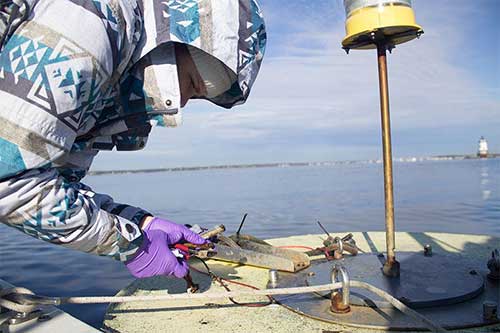
Last October in Providence, RI, STEEP Trainee Christine Gardiner learned that PFAS-containing fire-fighting foam was sprayed over a tanker truck spill of more than 12,500 gallons of petrol. She quickly contacted the Rhode Island Department of Environmental Management and arranged to join the next trip out to the bay, bringing empty bottles to collect water and home-made porous tubes filled with ionic powders that trap PFAS. These ‘passive samplers’ get attached to a rope on each buoy and remain in the water for about two weeks.
Gardiner plans to analyze the samples for about 20 known PFAS to see whether the method can capture them. She also hopes to see how the PFAS travelled through the bay. Together with her supervisor, Rainer Lohmann, and Grandjean, Gardiner is participating in a five-year $8.5-million project funded by the US National Institute of Environmental Health Sciences. A collaborator in the project, Elsie Sunderland at Harvard University in Cambridge, Massachusetts, is tracking some 30 PFAS from their sources to where they end up in the environment. Sunderland hopes that researchers could help people with high PFAS levels in their blood to trace the source of their exposure — perhaps to fish consumption, their drinking water or house dust.
The article also highlights work conducted by STEEP co-director Philippe Grandjean. Grandjean has studied how some of these PFAS substances affect children’s development. For 20 years, he has followed 500 children in the Faroe Islands from birth, measuring concentrations of five PFAS in their mothers’ blood and the children’s blood. (Grandjean picked the Faroese because, owing to their relatively isolated location, only a few PFAS show up in their blood, making the group easier to study than populations elsewhere.) In 2012, he reported that children with higher PFAS levels were less able to develop antibodies in response to vaccines.

